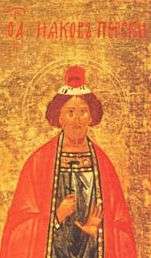James Intercisus
Saint James Intercisus, also known as Saint James the Mutilated (died 421) was a Syriac Christian saint born in Beth Huzaye (Syriac:ܒܝܬ ܗܘܙܝܐ) in Persia. His epithet, Intercisus, is derived from the Latin word for "cut into pieces," which refers to the manner of his martyrdom: he was slowly cut into twenty-eight pieces. His death started the Roman-Sassanid War (421-422).
Saint James Intercisus | |
|---|---|
 | |
| Born | Beth Huzaye (Persia) |
| Died | 421 Beth Lapat (Persia) |
| Venerated in | Eastern Orthodox Church Roman Catholic Church Eastern Catholic Churches Oriental Orthodoxy |
| Feast | 27 November 27 Hathor (Coptic Christianity)[1] |
.jpg)
His feast day is November 27.
Life
Tradition states that he was a military officer and courtier to Yazdegerd I who had apostatized after this ruler began to persecute Christians. Under the influence of his Christian family, however, he expressed his faith to Yazdegerd's successor, Bahram V, leading to his execution.[2]
Death
He was killed in Beth Lapat (Gundishapur). The ruins of this city are near Dezful, Iran.
At his execution, he survived the loss of limbs until he was beheaded. His followers requested his body parts as relics, but this request was denied, so they stole the body parts,[3] which were somehow sent to the Portuguese cathedral of Braga and put into a sarcophagus in the Relics Chapel.
Legend
James' story is recounted in The Golden Legend.
According to Katherine Rabenstein, he may be a composite character of James of Beit (who, having renounced Christianity under Yazdegerd, was shamed by his parents and changed his mind, becoming a martyr under the persecution of Bahram); Mar Peros (similarly shamed by his parents and martyred in 448); and James of Karka (a 20-year-old notary to Bahram, tortured alongside many others after casually remarking that he’d rather be cut into pieces than renounce God).[3]
Churches and monasteries
The Church of St. James Intercisus in the Armenian Quarter of Jerusalem was dedicated to him.[4]
The Monastery of St. Jacob Persian in Sireți, Strășeni Moldova, the Monastery of St. Jacob Persian in Deddeh, Lebanon and the monastery of St James the Mutilated in Qara, Syria are all dedicated to him.
References
- http://www.copticchurch.net/synaxarium/3_27.html#1
- John J. Delaney, Dictionary of saints, (Image, 2005), 323.
- Rabenstein, Katherine I. (1998). "saintpatrickdc.org". St. Patrick Catholic Church. Retrieved 19 March 2020.
- Adrian J. Boas, Jerusalem in the time of the Crusades, (Routledge, 2001), 128.
External links
- (in Italian) San Giacomo l'Interciso (il Solitario) Martire in Persia
- The Holy Martyr James the Persian
- (in Romanian) Monastery of St. Jacob Persian
Bibliography
- Thieleman J. van Braght, Martyr's Mirror, 1660